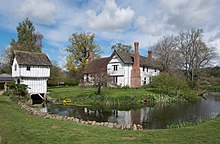
The Brockhampton Estate is a National Trust property in Herefordshire, England, and is to the north of the A44 Bromyard to Worcester road, opposite the northern edge of Bringsty Common and east from the town of Bromyard.
The significant aspect of the Estate is Lower Brockhampton, a timber framed manor house that dates to the late 14th century, surrounded by a moat, and entered by a restored gatehouse at the front of the house. The house is surrounded by 1,000 acres (400 ha) of farmland, some of it parkland, with specimen trees and 700 acres (280 ha) of woodland. In 2010, the National Trust undertook a major restoration of the house using traditional wattle and daub building methods.
The Brockhampton Estate was bequeathed to the National Trust in 1946 by Colonel John Lutley, in whose family it had been for more than twenty generations, although the name of the family had changed several times through marriage.
The site of the medieval village of Studmarsh is thought to be on the Estate; in 2012, an archaeological dig unearthed the foundations of two buildings that may have been part of the village.
Brockhampton and the Barneby family
Thomas Barneby, who was killed at the battle of Towton in 1461, married Isabella Whitgreave of Bockleton, heiress of the Brockhampton estate. One of his descendants was William Barneby, Sheriff of Worcester in 1605, who married Amphylis Lyttleton, a daughter of Sir John Lyttelton (1519–1590).
Amphylis Barneby's niece Bridget Marrow was a gentlewoman at the court of Anne of Denmark from 1603, and became keeper of her jewels. Amphylis wanted her nephew to join the household of Prince Henry. She wrote to her kinswoman, Meriel Lyttelton asking for advice. Lyttleton's reply was discouraging, saying that Amphylis's nephew Thomas Cornewall of Eastham and Burford had misinformed her. Cornewall had joined the Prince's household in 1603. However, when the time was right, Lyttleton's brother Henry Bromley of Holt would help her.
References
- "Historic building repair project is completed". Malvern Gazette. 24 July 2010. Retrieved 24 July 2010.
- Williams, Phyllis, Bromyard, Minster, Manor and Town
- "Lost medieval village of Studmarsh". Archived from the original on 15 September 2012. Retrieved 19 March 2013.
- John Burke, Genealogical and Heraldic History of the Commoners of Great Britain and Ireland, vol. 4 (London, 1838), pp. 1-3.
- Jo Ann Hoeppner Moran Cruz, An Account of an Elizabethan Family (Cambridge, 2018), p. 120: John Fetherston, Visitation of the County of Warwick in the Year 1619 (London, 1877), p. 69
- Jemma Field, 'A Cipher of A and C set on the one Syde with diamonds: Anna of Denmark’s Jewellery and the Politics of Dynastic Display', Erin Griffey, Sartorial Politics in Early Modern Europe (Amsterdam, 2019), p. 143.
- Henry Ellis, Original Letters Illustrative of British History, 2nd series vol. 3 (London, 1827), pp. 218-9 : Mary Anne Everett Green, Calendar State Paper Domestic, Elizabeth, 1601-1603 (London, 1870), p. 22: Cecil Foljambe, 1st Earl of Liverpool, The House of Cornewall (Hereford, 1908), pp. 217-8, 221
External links
52°12′4.68″N 2°27′30.96″W / 52.2013000°N 2.4586000°W / 52.2013000; -2.4586000
Categories: